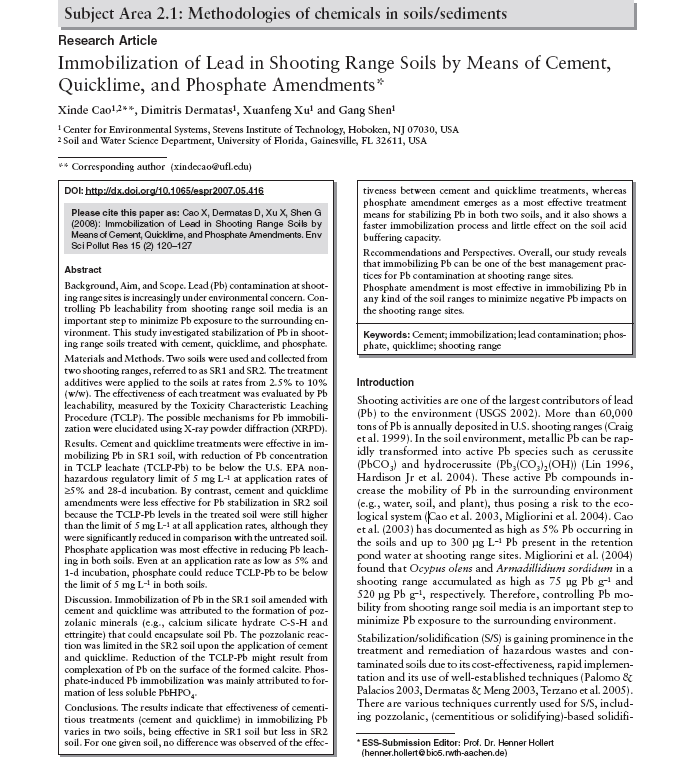Immobilization of Lead in Shooting Range Soils by Means of Cement, Quicklime, and Phosphate Amendments
2017-11-27
Xinde Cao, Dimitris Dermatas, Xuanfeng Xu and Gang Shen
Abstract
Background, Aim, and Scope. Lead (Pb) contamination at shooting range sites is increasingly under environmental concern. Controlling Pb leachability from shooting range soil media is an important step to minimize Pb exposure to the surrounding environment. This study investigated stabilization of Pb in shooting range soils treated with cement, quicklime, and phosphate. Materials and Methods. Two soils were used and collected from two shooting ranges, referred to as SR1 and SR2. The treatment additives were applied to the soils at rates from 2.5% to 10% (w/w). The effectiveness of each treatment was evaluated by Pb leachability, measured by the Toxicity Characteristic Leaching Procedure (TCLP). The possible mechanisms for Pb immobilization were elucidated using X-ray powder diffraction (XRPD). Results. Cement and quicklime treatments were effective in immobilizing Pb in SR1 soil, with reduction of Pb concentration in TCLP leachate (TCLP-Pb) to be below the U.S. EPA nonhazardous regulatory limit of 5 mg L–1 at application rates of ≥5% and 28-d incubation. By contrast, cement and quicklime amendments were less effective for Pb stabilization in SR2 soil because the TCLP-Pb levels in the treated soil were still higher than the limit of 5 mg L–1 at all application rates, although they were significantly reduced in comparison with the untreated soil. Phosphate application was most effective in reducing Pb leaching in both soils. Even at an application rate as low as 5% and 1-d incubation, phosphate could reduce TCLP-Pb to be below the limit of 5 mg L–1 in both soils. Discussion. Immobilization of Pb in the SR1 soil amended with cement and quicklime was attributed to the formation of pozzolanic minerals (e.g., calcium silicate hydrate C-S-H and ettringite) that could encapsulate soil Pb. The pozzolanic reaction was limited in the SR2 soil upon the application of cement and quicklime. Reduction of the TCLP-Pb might result from complexation of Pb on the surface of the formed calcite. Phosphate- induced Pb immobilization was mainly attributed to formation of less soluble PbHPO4. Conclusions. The results indicate that effectiveness of cementitious treatments (cement and quicklime) in immobilizing Pb varies in two soils, being effective in SR1 soil but less in SR2 soil. For one given soil, no difference was observed of the effectiveness between cement and quicklime treatments, whereas phosphate amendment emerges as a most effective treatment means for stabilizing Pb in both two soils, and it also shows a faster immobilization process and little effect on the soil acid buffering capacity. Recommendations and Perspectives. Overall, our study reveals that immobilizing Pb can be one of the best management practices for Pb contamination at shooting range sites. Phosphate amendment is most effective in immobilizing Pb in any kind of the soil ranges to minimize negative Pb impacts on the shooting range sites.
